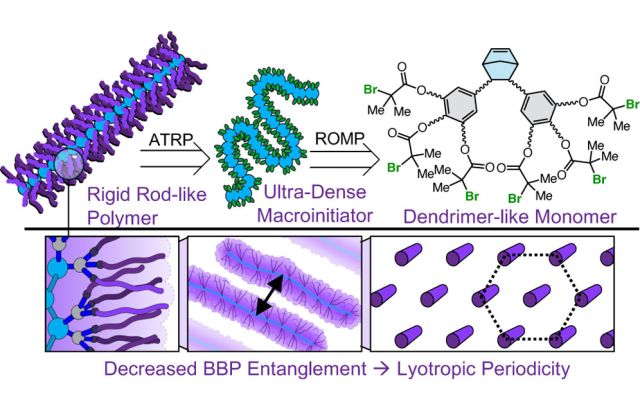The Precise Synthesis of Ultradense Bottlebrush Polymers Unearths Unique Trends in Lyotropic Ordering
New bottlebrush polymers mimic tissue structure through dense, ordered assembly.

PIs and Institution
Timea Kolozsvary, Phillip Kohl, Tianyu Li, David Gillespie, Youli Li, Benjamin R. McDonald, Brown University
Achievement
Ultradense bottlebrush polymers (BBPs) with high grafting density were synthesized using novel macroinitiators. These BBPs exhibited long-range lyotropic ordering and formed hexagonal arrays, a behavior not observed in conventional BBPs. The synthesis was scalable, providing multigram quantities of these materials. The materials were characterized using light scattering techniques, revealing the impact of grafting density on macromolecular rigidity and concentration induced ordering. The study provided fundamental insights into the solution-phase behavior of BBPs, laying the foundation for biomimetic materials with advanced mechanical properties.
Importance of the Achievement
Biology creates exceptional materials from relatively ordinary molecules via precise organization across multiple length scales. This research is significant as it enables the synthesis of BBPs that mimic the assembly behavior of tropocollagen, a key biomacromolecule that underpins the multiscale structure and mechanics of tissues. Consequently, new avenues have been opened for designing synthetic materials that mimic the fibrillar structures in tissues such as cartilage and skin, features that endow them with their exceptional robustness. Specifically, the study highlighted the crucial role of structural density and entanglement in BBP assembly, providing essential insights for the design of fabrication processes of hierarchically structured biomimetic materials.
Synergies with BioPACIFIC MIP
BioPACIFIC MIP enabled this study by providing access to its SAXS facility as well as the expertise of its project scientists Phillip Kohl and Youli Li. SAXS was used to characterize the solution-phase behavior of the ultradense bottlebrush polymers (BBPs) and confirm their long-range lyotropic ordering, with the project scientists’ expertise aiding in the data analysis.